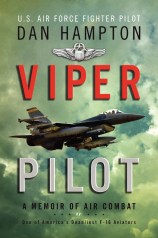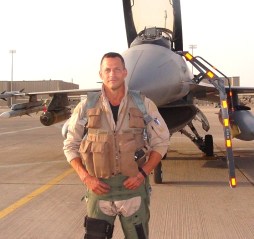An F-16 Wild Weasel like that flown by Hampton during the opening days of the Iraq war in 2003.
Retired Air Force lieutenant colonel Dan Hampton flew nearly 4,000 hours – including 726 in combat – in an F-16 during his 20 years in the Air Force. (Battleland has flown about, um, one, including none in combat. Final brave words as we hurtled down the runway: “Get us back safely, and there’s a cold case of Heineken in the trunk of my rental car.”) Hampton, who retired in 2006, has written about the experience in Viper Pilot: A Memoir of Air Combat.
The Air Force wanted to name its F-16 fighter the Falcon 30 years ago, but that name was already taken by a French business jet. Zut alors! So the service ended up calling it the Fighting Falcon (Department of Redundancy Department), which pilots thought was so dumb they’ve embraced Viper instead. More than 4,500 Vipers have been built. Hampton flew one tricked out as a radar-killing Wild Weasel, flying against enemy surface-to-air missile sites in the opening hours of air campaigns, to clear the way for others to follow. He also picked up four Distinguished Flying Crosses along the way. “Two Dogs” Hampton spoke with Battleland in an email interview recently.
Why did you write Viper Pilot: A Memoir of Air Combat?
I wanted people to get a glimpse into, and a more in depth appreciation of, a fighter pilot’s life. There’s lots of interest in military aviation and I wanted folks to see a bit of it. Maybe inspire a few younger people.
Tell us about your most memorable moment in the cockpit? Was that also the scariest? If not, tell us about both.

William Morrow
The most memorable moment was at the end of the last war [in Iraq]. We had made it home and were all landing amidst the crowds — waving flags, banners etc. As I shut down the engine and opened the canopy, I got a big breath of air — smelled like cut grass — and could hear the people cheering. It was a nice way to come back.
The scariest moment was probably discovering an Iraqi armored division the same instant they discovered me. I really thought I’d cashed in my chips.
How and why did you become a pilot?
Normal FAA license as a teenager but decided, as a sophomore in college, that wearing a tie and sitting in an office sounded less exciting than flying fast jets…so I applied for and received an officer’s commission and fought my way through two more years of jet training to the F-16.
Sum up the F-16 for us in a nutshell.
A multi-role, extremely versatile, lethal machine — and it looks good!
Tell us about your time with the Wild Weasels.
I learned the “trade” from the last of the Vietnam veteran pilots and got to train against the vast array of threats presented by the Soviet Union. Combat was against these same threats, but in a different theater of operations, so we had to adapt.
We were able to do this because of the F-16’s inherent capabilities, advances in both countermeasures and weapons, and our own aggressiveness. I never lost a wingman and I did destroy 21 SAM sites with bombs, Maverick missiles and the 20mm cannon.

Dan Hampton
You have a chest full of medals. But do you wish you’d had the chance to become an Ace? Are the days of dog-fighting and air-to-air combat gone forever?
I never say never. If we fight another top-tier threat like China or the “new” Russia then there will be dogfights. Every fighter pilot wants to shoot down jets, but it’s just as satisfying to duel with a SAM and win.
You have flown some pretty exciting missions. Tell us a little about your top three.
— The first daylight mission into Baghdad in 1991 — all before had been at night. This time they were awake and waiting for us, and if anything had gone wrong there was no hope of rescue 300 miles behind the lines.
— Nasiriyah, Iraq, in 2003. This was a close-air support mission in atrocious weather conditions to try and save surrounded Marines. No choice but to try.
— Killing Saddam’s escape helicopters — bad weather, right over Baghdad and every SAM or piece of Triple-A in the area shooting at us. Again, had to be done or he might’ve gotten away and prolonged the war.
Drones seem to be taking over more and more of what manned aircraft used to do…do you think manned fighter aircraft will become obsolete?
Not a chance. Drones can operate now because real aircraft have killed the MiGs and SAMs for them. In any kind of non-permissive, dangerous environment (or just bad weather) the drones won’t cut it.
They also can’t carry the weapons we do nor can they “think” at 38 trillion times per second like the human brain.
Has airpower been used properly by the U.S. military since 9/11?
To an extent. Tactical air power is designed to fight other types of tactical air power — not necessarily Mexican drug lords or terrorists. But it could be better adapted to give the killing punch in the situations. Old cliche but true — the military is usually fighting the last war.


